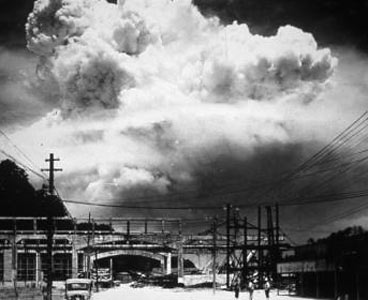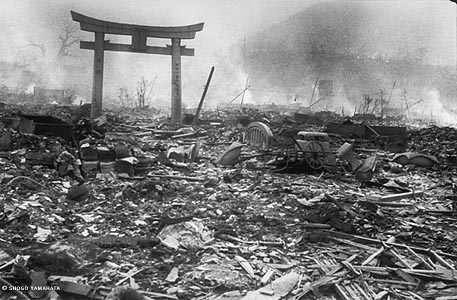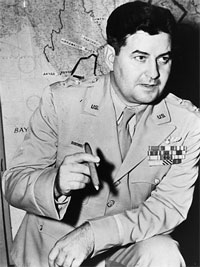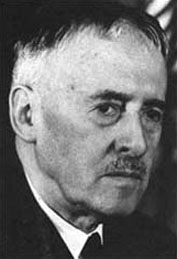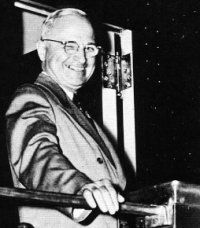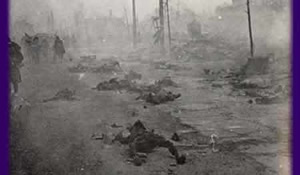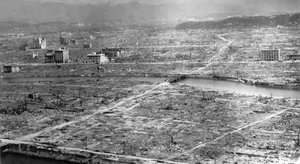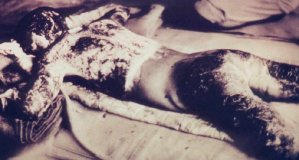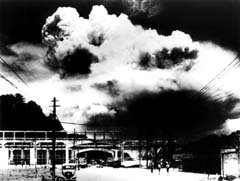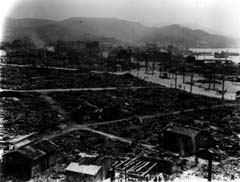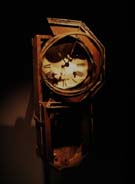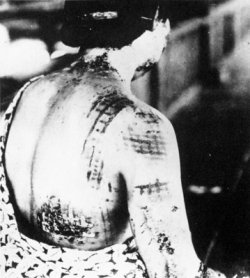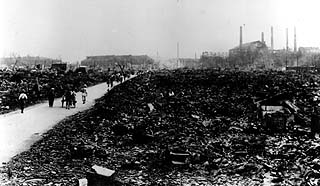11:02 A.M. August 9, 1945. Nagasaki, Japan.

Found in a house near Sanno Shinto Shrine in Sakamoto-machi, about one kilometer from the hypocenter. The clock was shattered by the blast, and its hands stopped at 11:02?@ef;bc;the moment of the explosion.
Seventy years ago today, at 11:02 in the morning, without warning, Major Charles Sweeney flew a U.S. B-29 bomber over the city of Nagasaki. The thing about Nagasaki is that it wasn’t even supposed to be bombed that day. Sweeney was acting on orders from General Curtis LeMay, the head of the XXI Bomber Command, and at the command of Secretary of War Henry L. Stimson, and President Harry S. Truman. A U.S. bomber had already dropped a uranium bomb on Hiroshima only three days before, annihilating 90% of the city and consuming 140,000 lives in the atomic fires. On August 9, while the Japanese government was still gathering information about what had happened at Hiroshima, while the Imperial council was still in session and still debating the question of surrender, without warning, they flew out a second bomber mission. The intended target was Kokura, but when Sweeney reached Kokura at 9:44am, he couldn’t see his target. He couldn’t see it because the U.S. had firebombed another nearby city, Yawata, the day before, and the smoke from the burning city hid Kokura from his sight. So Sweeney flew on to his secondary target — to Nagasaki. Clouds also hid the target in Nagasaki, but the plane was low on fuel and could not fly on to any other targets. So, at 11:02 in the morning, the plane’s bombadier, Captain Kermit Beahan, dropped a 10,200 pound plutonium bomb (nicknamed Fat Man
) over this tourist destination, industrial center and sea-port in southwestern Japan with a population of about 230,000.
The bomb exploded about 500 yards above Nagasaki.
Known as Urakami, the district around the hypocenter (ground zero) area had been populated for centuries by Japanese people of the Roman Catholic faith. At the time of the bombing, between 15,000 and 16,000 Catholics – the majority of the approximately 20,000 people of that faith in Nagasaki and about half of the local population – lived in the Urakami district. It is said that about 10,000 Catholics were killed by the atomic bomb. Although traditionally a rustic isolated suburb, the Urakami district was chosen as the site for munitions factories in the 1920s, after which time the population soared and an industrial zone quickly took shape. The district was also home to the Nagasaki Medical College and a large number of other schools and public buildings. The industrial and school zones of the Urakami district lay to the east of the Urakami River, while the congested residential district of Shiroyama stretched to the hillsides on the west side of the river.
It was over this section of Nagasaki that the second atomic bomb exploded at 11:02 a.m., August 9, 1945. The damages inflicted on Nagasaki by the atomic bombing defy description. The 20 machi or neighborhoods within a one kilometer radius of the atomic bombing were completely destroyed by the heat flash and blast wind generated by the explosion and then reduced to ashes by the subsequent fires. About 80% of houses in the more than 20 neighborhoods between one and two kilometers from the hypocenter collapsed and burned, and when the smoke cleared the entire area was strewn with corpses. This area within two kilometers of the hypocenter is referred to as the
hypocenter zone.The destruction caused by the atomic bomb is analyzed as follows in Nagasaki Shisei Rokujugonenshi Kohen [History of Nagasaki City on the 65th Anniversary of Municipal Incorporation, Volume 2] published in 1959. The area within one kilometer of the hypocenter: Almost all humans and animals died instantly as a result of the explosive force and heat generated by the explosion. Wooden structures, houses and other buildings were pulverized. In the hypocenter area the debris was immediately reduced to ashes, while in other areas raging fires broke out almost simultaneously. Gravestones toppled and broke. Plants and trees of all sizes were snapped off at the stems and left to burn facing away from the hypocenter.
The area within two kilometers: Some humans and animals died instantly and a majority suffered injuries of varying severity as a result of the explosive force and heat generated by the explosion. About 80% of wooden structures, houses and other buildings were destroyed, and the fires spreading from other areas burned most of the debris. Concrete and iron poles remained intact. Plants were partially burned and killed.
The area between three and four kilometers: Some humans and animals suffered injuries of varying severity as a result of debris scattered by the blast, and others suffered burns as a result of radiant heat. Things black in color tended to catch fire. Most houses and other buildings were partially destroyed, and some buildings and wooden poles burned. The remaining wooden telephone poles were scorched on the side facing the hypocenter.
The area between four and eight kilometers: Some humans and animals suffered injuries of varying severity as a result of debris scattered by the blast, and houses were partially destroyed or damaged. The area within 15 kilometers: The impact of the blast was felt clearly, and windows, doors and paper screens were broken. Wall clock found in Sakamoto-machi about 1 km from the hypocenter. The hands stopped at the moment of the explosion: 11:02 a.m.
The injuries inflicted by the atomic bomb resulted from the combined effect of blast wind, heat rays (radiant heat) and radiation and surfaced in an extremely complex pattern of symptoms. The death toll within a distance of one kilometer from the hypocenter was 96.7% among people who suffered burns, 96.9% among people who suffered other external injuries, and 94.1% among people who suffered no apparent injuries. These data show that the deaths occurring immediately after the atomic bombing were due not only to burns and external injuries but also to severe radiation-induced injuries. The late medical effects of atomic bomb exposure include
keloidscars, atomic bomb cataracts, leukemia and other cancers and microcephaly (small head syndrome) due to intrauterine exposure. Although aware that the atomic bomb had the power to instantly kill or injure all people within a radius of four kilometers, the authorities were unable to determine the death toll and number of injuries in Nagasaki. Still today there is no accurate data on the number of people who died. A variety of factors contributed to this lack of information, such as the paralysis of administrative functions in the aftermath of the bombing and the inability of the postwar government to initiate a proper investigation. Another obstacle was the enduring nature of disorders related to atomic bomb exposure. A progressive increase can be expected, therefore, at whatever point in time calculations are made. There are countless cases of people who suffered injuries on August 9 and died after fleeing to areas outside Nagasaki city and prefecture, only to be registered as dying of causes other than the atomic bombing. Because of the lack of knowledge about radioactive contamination, meanwhile, many radiation deaths were attributed to diseases. The Nagasaki municipal government officially adopted the figure ofmore than 70,000deaths on the basis of information from population surveys and the estimate made by the Nagasaki City Atomic Bomb Records Preservation Committee in July 1950. Said the committee in its report:73,884 people were killed and 74,909 injured, and 17,358 of the deaths were confirmed by post-mortem examination soon after the atomic bombing.
About 24 hours before the incineration of Nagasaki, U.S. planes had begun dropping leaflets all over Japan, threatening more destruction like the massacre of Hiroshima two days before. But they named no targets that might be evacuated. Shortly before these leaflets were dropped, Harry Truman also publicly declared his aims: It was to spare the Japanese people from utter destruction that the ultimatum of July 26 was issued at Potsdam. Their leaders promptly rejected that ultimatum. If they do not now accept our terms, they may expect a rain of ruin from the air the likes of which has never been seen on this earth.
The leaflets themselves read:
TO THE JAPANESE PEOPLE:
America asks that you take immediate heed of what we say on this leaflet.
We are in possession of the most destructive explosive ever devised by man. A single one of our newly developed atomic bombs is actually the equivalent in explosive power to what 2000 of our giant B-29s can carry on a single mission. This awful fact is one for you to ponder and we solemnly assure you it is grimly accurate.
We have just begun to use this weapon against your homeland. If you still have any doubt, make inquiry as to what happened to Hiroshima when just one atomic bomb fell on that city.
Before using this bomb to destroy every resource of the military by which they are prolonging this useless war, we ask that you now petition the Emperor to end the war. Our president has outlined for you the thirteen consequences of an honorable surrender. We urge that you accept these consequences and begin the work of building a new, better and peace-loving Japan.
You should take steps now to cease military resistance. Otherwise, we shall resolutely employ this bomb and all our other superior weapons to promptly and forcefully end the war.
The leaflets did not reach Nagasaki at all until August 10, the day after it was destroyed.
The purpose of this massacre was to achieve victory through catastrophic bloodshed and terror. LeMay, when asked about his bombing campaigns, stated There are no innocent civilians, so it doesn’t bother me so much to be killing innocent bystanders.
(He also mused, later, I suppose if I had lost the war, I would have been tried as a war criminal.
) The interim committee deciding to drop the bomb stated, on May 31, 1945, that we could not give the Japanese any warning
before the atomic bombing of Hiroshima. Of course, no specific warning was given to the civilians of Nagasaki, either, at any point. The point of the bombing was to kill as many people as possible while wiping two cities off of the face of the earth.
The massacres at Nagasaki and Hiroshima were at the end of a half-year long terror-bombing campaign that included the Operation Meetinghouse
firebombing of Tokyo in March 1945, which killed 100,000 civilians over a single night, and the low-altitude firebombing of over 60 other Japanese cities. The 74,000 souls who died at Nagasaki were among some 800,000-1,000,000 civilians killed by months of low-altitude firebombing, conventional
high explosives, and atomic bombs over the course of 6 months. Seventy years ago today also, in a radio address, President Harry S. Truman said: Having found the bomb, we have used it. . . We wished in this first attack to avoid, insofar as possible, the killing of civilians. . . . We have used it in order to shorten the agony of war.
After the war, Truman defended his decision to annihilate two industrial metropolises with atomic weapons, and to kill a quarter of a million civilians within only 72 hours, by claiming that it was the only way to coerce the political goal of an unconditional surrender from the Japanese government, and to reduce the number of U.S. soldiers who might be killed in combat.
Also.
- GT 2015-08-06: 8:15am. 70 years. 140,000 souls.
- GT 2005-08-09: A day that will live in infamy
- Anthony Gregory, Hiroshima, Nagasaki, and the U.S. Terror State, The Libertarian Standard (August 6, 2013)
- Ralph Raico, Hiroshima and Nagasaki, Antiwar.com (August 5, 2009).
- Artefacts tagged
Nagasaki
at Dulce Et Decorum Est - Nagasaki Atomic Bomb Museum, city of Nagasaki, Japan
Remembering Nagasaki,
photography by Yosuke Yamahata, at the Exploratorium
